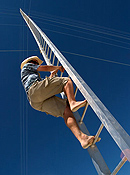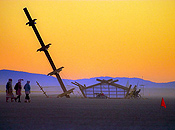In 2005, Black Rock City experienced a peak year for art. The community achieved a record number of completed art installations—275 in all, including 190 registered projects and 85 “walk-in” or unregistered projects. Only 28 registered projects failed to appear. The year saw more collaborative projects than ever before, and we hope to see more in the future.
Psyche Theme
 Our 2005 art theme, The Psyche: The Conscious, the Subconscious, and the Unconscious proved extremely popular with participants and inspired a marvelous variety of art installations. The Man stood on a Funhouse that contained an elaborate maze, each of its 41 rooms filled with interactive art. Participants explored these rooms until they found their way to the upper level, where they encountered a Burning Man trimmed in hot pink and lime green neon, standing on a turntable. With the help of others, they could turn the Man, whose rotation the designers hoped would disorient participants, in keeping with the theme. For more information on the Man and the Funhouse, please check out the Man and Platform Afterburn report.
Our 2005 art theme, The Psyche: The Conscious, the Subconscious, and the Unconscious proved extremely popular with participants and inspired a marvelous variety of art installations. The Man stood on a Funhouse that contained an elaborate maze, each of its 41 rooms filled with interactive art. Participants explored these rooms until they found their way to the upper level, where they encountered a Burning Man trimmed in hot pink and lime green neon, standing on a turntable. With the help of others, they could turn the Man, whose rotation the designers hoped would disorient participants, in keeping with the theme. For more information on the Man and the Funhouse, please check out the Man and Platform Afterburn report.
Honoraria
 The year 2005 brought exciting changes for the art department, particularly for the theme art and grant program. An increase in the grant budget from $250,000 to $425,000 funded more ambitious and complex projects. Other changes to the honorarium process responded to a request from a group of (mostly) local artists and participants who wanted a more democratic and inclusive process. “Borg2” challenged Burning Man to an art bet and raised funds for their own grant program, accomplished by public vote. Despite rocky beginnings, their elected Art Council worked with the Burning Man Projects Art Department to bring eight funded projects to the playa, six of which were completed. Two changes in the funding process in response to their request included dropping the requirement that projects be based on the annual art theme in order to receive funding and dropping a clause from the grant contract relating to reimbursing Burning Man a percentage of the sales of funded projects. Considerable misunderstandings about the funding process became apparent during the Borg2 conflict, and the Projects response involved a document added to the website: Top Ten Burning Man Art Myths.
The year 2005 brought exciting changes for the art department, particularly for the theme art and grant program. An increase in the grant budget from $250,000 to $425,000 funded more ambitious and complex projects. Other changes to the honorarium process responded to a request from a group of (mostly) local artists and participants who wanted a more democratic and inclusive process. “Borg2” challenged Burning Man to an art bet and raised funds for their own grant program, accomplished by public vote. Despite rocky beginnings, their elected Art Council worked with the Burning Man Projects Art Department to bring eight funded projects to the playa, six of which were completed. Two changes in the funding process in response to their request included dropping the requirement that projects be based on the annual art theme in order to receive funding and dropping a clause from the grant contract relating to reimbursing Burning Man a percentage of the sales of funded projects. Considerable misunderstandings about the funding process became apparent during the Borg2 conflict, and the Projects response involved a document added to the website: Top Ten Burning Man Art Myths.
Adjustments to the grant process made it more transparent to the public. For the first time, the Jackrabbit Speaks (JRS) newsletter announced the grant proposal deadline, directing prospective applicants to online grant guidelines. As a result, applicants submitted 140 proposals, up from 80 in 2004.
In addition, the curatorial committee expanded from three to five people. The streamlined process in 2005 resulted in grant decisions on March 1, allowing Project staff to meet with all the artists, sign contracts, and issue funds by April 1—earlier than ever before. All 32 funded projects reached successful completion.
After selecting the grant projects, the streamlined management process completed all of the contract signing meetings with artists during the month of March, enabling payments to start in April, earlier in the year than ever before. Efficiency increased further through the assistance of Artist Support Services and fuel personnel. A new ticket system also helped with ticket orders and scheduling of early arrivals. To keep the public informed about the funded projects, a regular series of articles appeared in the JRS called Spotlight on the Funded Projects.
To educate participants about lighting their art properly, the website gained a new article, Lighting Your Art Installation.
All art sites must be left pristine, without burn scars, rebar, or matter out of place (MOOP) after the event. The checkout process helps to ensure that projects depart the playa correctly, allowing both the artists and Burning Man to view their sites, give feedback, and sign off on the project. This year, nearly all funded artists checked out at departure. For 2006, the artists received more frequent reminders, including contacts on the playa, so that they dont forget.
 Zachary Coffins monumental kinetic sculpture Colossus stood in the Keyhole directly above Center Camp, and its three tall spikes could be seen from anywhere on the playa, constantly in motion as participants slowly spun the huge boulders suspended from its metal arms. Colossus very successfully anchored the Keyhole and provided a focal point for the city center.
Zachary Coffins monumental kinetic sculpture Colossus stood in the Keyhole directly above Center Camp, and its three tall spikes could be seen from anywhere on the playa, constantly in motion as participants slowly spun the huge boulders suspended from its metal arms. Colossus very successfully anchored the Keyhole and provided a focal point for the city center.
In keeping with the Psyche theme, Pepe Ozan created the Dreamer, an enormous walk-in sculpture of a head that appeared to be submerged to the nose in the playa surface. It occupied a spot on the walkway from Center Camp to the Temple of Dreams, halfway between the Man and the Temple to symbolically divide the playa between zones of waking and sleeping or consciousness and the unconscious. Inside the head, a central chimney was surrounded by blood vessels, ganglia, and lifelike tissue. A central area accommodated funded fire art projects, the Fire Dream Circle, composed of five installations around the Dreamer. These were the Angel of the Apocalypse by the Flaming Lotus Girls, the Fire Pod by Buphalo, Synapses by Charlie Smith and Jaime Ladet, Ajna by Kasia Wojnarski, and the Fire Pendulums by Danya Parkinson and Joe Bard. This composition created a visually striking area of fire beyond the Man, visible from Center Camp. Some of the artists felt that placement so close to other fire art diminished the drama and uniqueness of their projects. Several indicated that they would have preferred to be placed along the Esplanade or out in the deep playa. This arrangement will not return for 2006.
 In 2005 the communitys Temple again appeared in its usual position behind the Man. David Best passed along the task of creating the Temple of Dreams to his crew member, Mark Grieve. Mark and the crew created lovely red Japanese-style pagodas, which were constantly in use. As always, shrines, altars, photos, and written tributes accumulated in the Temple grounds throughout the week, making it once again the communitys sacred place of grieving and remembrance. Another massive collaborative project was Seattles Machine, a huge and complex wood and metal structure containing an elaborate system of gears and conveyor belts. At least sixteen artists participated in its design, planning, and execution, and they were joined by dozens more workers to bring it to life. The action of participants turning three “people wheels” caused its huge arms to rise to great height before the entire installation was pulled down. The Machine proved stronger than puny humans, however, and after participants failed to bring it down, the Department of Public Works (DPW) stepped in to assist with heavy machinery.
In 2005 the communitys Temple again appeared in its usual position behind the Man. David Best passed along the task of creating the Temple of Dreams to his crew member, Mark Grieve. Mark and the crew created lovely red Japanese-style pagodas, which were constantly in use. As always, shrines, altars, photos, and written tributes accumulated in the Temple grounds throughout the week, making it once again the communitys sacred place of grieving and remembrance. Another massive collaborative project was Seattles Machine, a huge and complex wood and metal structure containing an elaborate system of gears and conveyor belts. At least sixteen artists participated in its design, planning, and execution, and they were joined by dozens more workers to bring it to life. The action of participants turning three “people wheels” caused its huge arms to rise to great height before the entire installation was pulled down. The Machine proved stronger than puny humans, however, and after participants failed to bring it down, the Department of Public Works (DPW) stepped in to assist with heavy machinery.
Theme Art
 Art based on the annual theme sat along the Esplanade, on the four crosswalks radiating from the Man to the Esplanade, and in the deep playa all the way to the boundaries of Black Rock City. Nearly 100 projects ranged from a 108-foot tall vertical ladder to a Stonehenge made of refrigerators, all manner of brains, psychological counseling centers, temples, see-saws, train stations, and scattered fossils. Please take a look at the theme art page of the website to see the depth and variety of the work.
Art based on the annual theme sat along the Esplanade, on the four crosswalks radiating from the Man to the Esplanade, and in the deep playa all the way to the boundaries of Black Rock City. Nearly 100 projects ranged from a 108-foot tall vertical ladder to a Stonehenge made of refrigerators, all manner of brains, psychological counseling centers, temples, see-saws, train stations, and scattered fossils. Please take a look at the theme art page of the website to see the depth and variety of the work.
Playa Art
The playa hosted a record number of art installations—nearly 20—not based on the annual theme in 2005. Planners refer such pieces to as Playa Art.
 Playa art shares the Esplanade and the deep playa with theme art, and some pieces help to fill the inner circle of the city surrounding the Man. The list included a gigantic Mousetrap game, a submerged effigy of the Man, a power plant, a tea temple, a library, and a flaming Zen garden.
Playa art shares the Esplanade and the deep playa with theme art, and some pieces help to fill the inner circle of the city surrounding the Man. The list included a gigantic Mousetrap game, a submerged effigy of the Man, a power plant, a tea temple, a library, and a flaming Zen garden.
Black Rock City experienced a fantastic year for art in 2005, perhaps the best ever, and The Burning Man Project thanks the community for all their hard work, great ideas, and commitment to bringing interactive art to the playa.
Submitted by Christine Kristen, aka LadyBee

